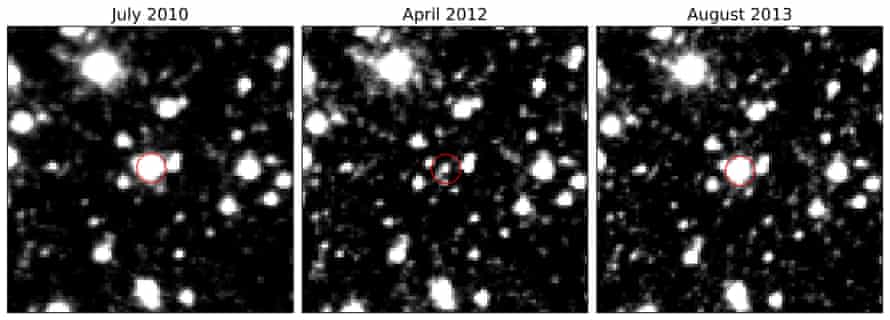Huge star, 25,000 light years away, dims by 97% then slowly returns to former brightness
Source: The Guardian
Astronomers have spotted a giant blinking star, 100 times the size of the sun, lurking near the heart of the Milky Way.
Telescope observations revealed that over a few hundred days the enormous star, which lies more than 25,000 light years away, dimmed by 97% and then slowly returned to its former brightness.
The unexpected and dramatic darkening was probably caused by an orbiting planet or companion star surrounded by a disc of opaque dust crossing in front and blocking out light that would otherwise have reached Earth.
“It appeared to come out of nowhere,” said Dr Leigh Smith at Cambridge University’s Institute of Astronomy, on the sudden dimming of the star. It began to fade in early 2012 and almost vanished by April that year before recovering over the next 100 days.

Astronomers noticed the mysterious dimming star in data gathered by the Vista telescope, operated by the European Southern Observatory in Chile. The instrument has been watching a billion stars for nearly a decade in search of examples that varied in brightness in the infrared realm of the electromagnetic spectrum.
When scientists find variable stars that do not sit within established categories, they call them “what is this” or “WIT” objects. Their latest discovery bears the name VVV-WIT-08.
Because the huge star was in such a dense region of the galaxy, the researchers wondered whether an unknown dark object might have strayed in front of it by chance. Simulations suggested this was highly unlikely without an implausible number of dark objects floating around the Milky Way.
Far more probable was that the telescope’s view of VVV-WIT-08 was obscured when a dusty disc around an orbiting planet or second star got in the way. The astronomers’ calculations, reported in the Monthly Notices of the Royal Astronomical Society, suggested the disc was tilted to look like an ellipse from Earth and had to be gigantic, having a radius at least a quarter of the distance from the Earth to the sun.
It is not the first blinking star astronomers have discovered. A huge dust disc causes the giant star Epsilon Aurigae to dim by about 50% every 27 years. Another star known as TYC 2505-672-1 is part of a binary system and is eclipsed by the disc around its companion star every 69 years. It is unclear when VVV-WIT-08 will dim again, but astronomers believe it will happen in the next 20 to 200 years. Two more blinking stars were spotted alongside VVV-WIT-08, but the researchers have fewer details on these.
The flurry of discoveries will help astronomers understand what seems to be a new class of “blinking giant” stars. “Once you start to build up collections of several of these things, you can look at their properties in aggregate and unpick the mysteries of where these discs come from,” said Smith. “It allows us to learn how these systems evolve and what they do at the end of their lives.”
Source: The Guardian

































Leave a Comment
You must be logged in to post a comment.